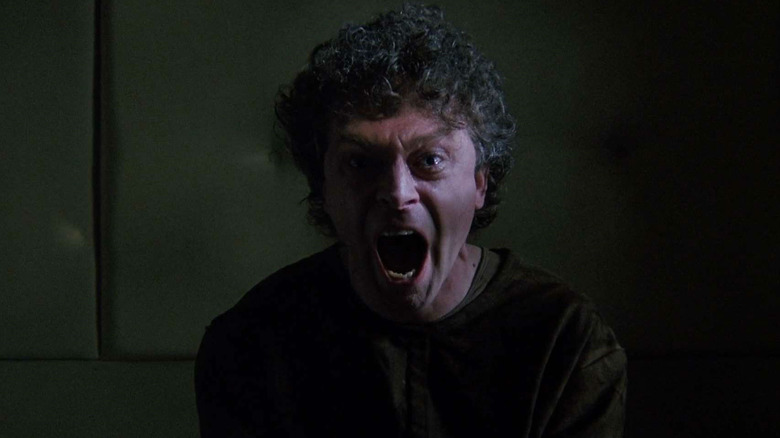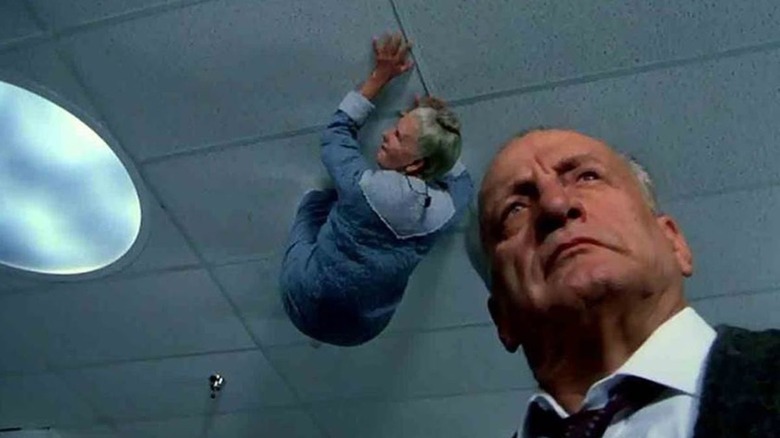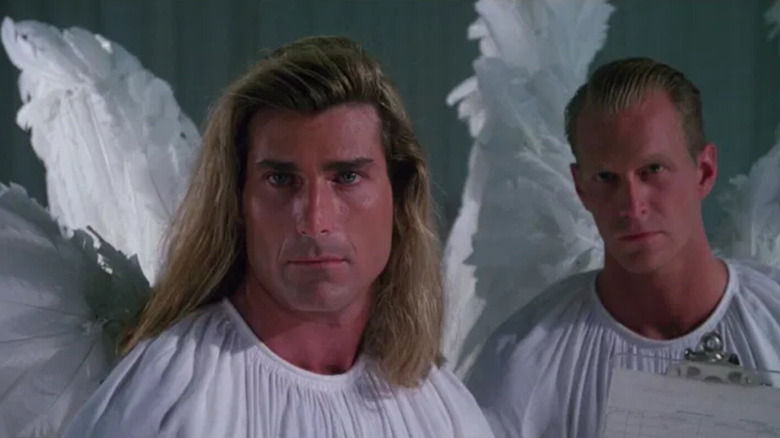
With a series of idiosyncratic filmmakers, studio interference, and more 180-degree twists than Linda Blair’s head, “The Exorcist” has to be one of the weirdest franchises to ever come out of Hollywood. That said, its flaws are also a boon – the films are far more interesting than the usual cookie-cutter horror sequels, with each entry feeling like a personal statement from its director, for better or worse. Well, usually for the worse.
Case in point: 1990s “The Exorcist III.” After the wacky metaphysics of John Boorman’s widely derided “Exorcist II: The Heretic,” writer and “The Exorcist” author William Peter Blatty kicked off a story called “Legion.” for another sequel that would ignore the events of Boorman’s film. Warner Bros. was enthusiastic, but after “The Exorcist” director William Friedkin left due to creative differences, the project ended up languishing in development hell. Blatty decided to turn “Legion” into a novel – and it became a bestseller.
Due to this success, Blatty adapted the book into a screenplay, which was picked up by Morgan Creek Productions. While the writer initially offered John Carpenter the director job, that partnership fell through as they disagreed on the ending. And oh, Carpenter felt that Blatty himself wanted to direct this one. The “Exorcist” writer was given the chance to become a writer and director, but the studio demanded it be titled “The Exorcist III” because they wanted to maintain brand awareness. Despite the fact that the script didn’t feature any actual exorcisms. But the leaders also had some ideas about it.
The end result is a riveting occult murder mystery that captures the brooding malevolence of Friedkin’s first film and vastly improved upon the second entry – but is too wordy and has a blatant exorcism scene at the end. With that, it’s time to examine Blatty’s original intentions and how forced studio changes turned him into something else.
So what else is going on in The Exorcist III?

“The Exorcist III” opens 15 years after the events of the 1973 original. Movie-loving detective William Kinderman (George C. Scott) and his friend Father Dyer (Ed Flanders) attempt to cheer each other up on the occasion of the anniversary of the death of Father Karras, their mutual friend who perished by falling from a steep staircase after the exorcism at the end of the first film.
Meanwhile, something infernal once again lurks in the Georgetown neighborhood. An evil force invades a church, a priest is killed in his own confessional, and a young black man is murdered in a gruesomely sacrilegious and racist manner. But the fingerprints found at the two crime scenes do not match, indicating that more than one person is behind the murders. Kinderman realizes this matches the modus operandi of James Venamun (Brad Dourif), aka the Gemini Killer, who was executed the night Karras died.
After Father Dyer is gruesomely murdered in hospital while there for a checkup, Kinderman’s investigations lead him to Patient X (Jason Miller), a man on a psychiatric ward who was arrested 15 years earlier, wandering the streets. and suffering from amnesia. The detective suspects that the Gemini Killer is somehow behind the new wave of murders despite his death, and is even more shocked to discover that the mysterious patient is the spitting image of Father Karras.
On top of all that, Patient X knows a lot more about the past and present murders than seems possible – after all, the press was given false information to weed out crackpots claiming responsibility. As the murders pile up in “The Exorcist III,” Kinderman must solve the case before the killer strikes again.
Studio requirements and other issues

For the first hour or so, “The Exorcist III” is a masterful slow etching by William Peter Blatty. It reintroduces us to Detective Kinderman and Father Dyer, two supporting characters who provided the original film with a surprisingly upbeat note of friendship at its conclusion. Much of the fun of the opening act is the gritty comedy between the two, which gives the film plenty of warmth and humor. Blatty uses it as a counterweight, against an eerie atmosphere and bizarre, unsettling images. An effigy of Christ opens its eyes in horror, while a campy dream sequence in “Heaven Station” features unlikely cameos – Samuel L. Jackson, Fabio Lanzoni and Patrick Ewing. It all gradually builds towards a powerful two-man match between Kinderman and Father Karras/James Venamun, and one of the biggest jump scares I’ve ever seen.
But things get a little confusing during Kinderman’s long confrontation with Patient X. In the original version of the film – a Director’s Cut was released in 2016 – the role constantly switches between Jason Miller and Brad Dourif, making it hard to know. who or what the detective actually sees in front of him. I could have totally accepted Dourif as the image of Father Karras, just as I did not question George C. Scott and Ed Flanders in the roles of Kinderman and Father Dyer. Throwing Miller into the mix also wreaked havoc on my brain, and not in a good way.
Except it’s a minor issue compared to the ending of “The Exorcist III.” Four months after the film was completed, the studio insisted that Blatty shoot a new, high-impact conclusion involving an exorcism. Nicol Williamson was parachuted in to play Father Morning, a priest who seems to appear out of nowhere to perform the rite. While the scene more or less works, it seems completely at odds with the tone of the rest of the movie.
Who exactly is patient X in The Exorcist III?

In the Director’s Cut of “The Exorcist III”, Lt. Kinderman has Father Karras exhumed and finds that someone else was buried in his place. We are later told the story of Brother Fain, an elderly priest who was the last person to see Karras’ body before his funeral. Fain subsequently disappeared, which his superiors dismissed as his return home to die after suffering two heart attacks. An autopsy reveals that he died after a third and everything indicates that he was scared to death.
During a long monologue, patient X tells us how everything happened. “The Master” was furious that Father Karras exorcised the demon Pazuzu from Regan MacNeil (Linda Blair) at the end of the first movie. In revenge, he hit Karras where it would hurt the most: his soul. He helped the Gemini Killer/James Venamun – freshly executed and floating like a spirit – gain access to the priest’s body as he lay dying at the bottom of the steps. The killer then climbed out of his coffin into his new body, scared poor old Brother Fain to death, and buried Fain’s body instead of Karras’.
But since Karras suffered severe brain damage from falling down the steps, Patient X was nearly catatonic when he was found wandering the streets the night Karras and Venamun died. It took 15 years to restore Karras to a functioning body and mind ready to resume the killing. It’s a dastardly punishment for Karras, with his soul trapped in his old body with Venamun and his demon friends, while being forced to watch the Gemini Killer commit other evil deeds.
Vs original. Director’s cut

In both versions of “The Exorcist III”, Detective Kinderman deduces that the Gemini Killer is jumping from bodies to commit more murders. After a little mistake involving a cute kid, Kinderman realizes that one of the room killer’s “old friends” is about to murder his family. He rushes home to thwart the attempt, which is where the two cups diverge.
In the original theatrical version, the Gemini Killer’s attack on Kinderman and his family is cut short when Father Morning intervenes with an exorcism, getting severely maimed in the process. Kinderman returns to the hospital and Patient X returns his powers to the detective, who is only saved when Karras manages to take control of his body. Kinderman shoots him down, freeing Karras from his torment, and “The Exorcist III” ends abruptly with Kinderman standing by the priest’s grave.
The Director’s Cut, pieced together from VHS footage from the film’s production, gives us a better idea of William Peter Blatty’s original vision. The VHS scenes are low quality, but they contain some extra exposure to help us understand what’s going on. To clear things up, Patient X is only played by Brad Dourif, which makes it more obvious that he’s meant to look like Father Karras.
But the biggest change is reserved for the end. The Gemini Killer’s murderous plan is halted when Karras fights back, saving his old friend Kinderman. The detective then returns to the hospital to release Karras from his suffering – an act of love that also spells the end for the detective. Without the (forced) exorcism, Kinderman is likely to be arrested for shooting a patient in his cell. It’s a darker, but much more satisfying ending.




Add comment